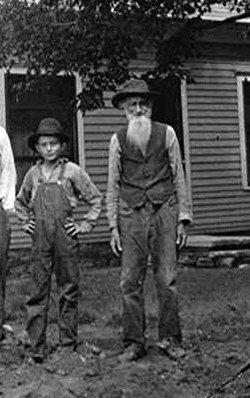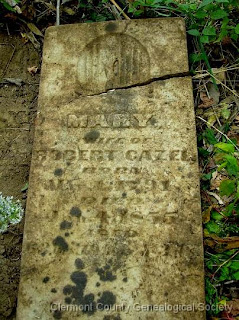George Bowman - Fort Amanda Soldier
1793 - 1873
This photo of George W. Bowman was taken in November 1865 when he was 72 years old.
Bowman was born on Oct. 6, 1793 in Somerset County, New Jersey the fourth child of Richard (b. 1767) and Mary (Senteny) Bowman (b. 1769). Richard was a Revolutionary War veteran. George's father was a cordwainer, “a shoemaker who makes fine soft leather shoes and other luxury foot ware articles.”
The Bowman family moved to Kentucky between 1796 and 1799. Three years later (1802) they moved to Hamilton County, Ohio. The last of the Bowman children, William, was born the same year his older brother George went off to war (1813).
When the War of 1812 broke out, 20
year old George was assigned to Captain Daniel Hosbrooks company. He was living with his parents in Sycamore Township Sec. 13 T3
ER2 at the time (btm. right corner).
On March 29, 1813, while George was on active duty, his parents sold the family farm. (marked with the "X")
 |
| Street Level View of "X" looking west at the original Bowman property. |
In 1813, shortly after returning from Ft. Amanda, George
married Phebe Thompson. They
purchased land in Sycamore Township (Section
17, T4 ER)
 |
 |
| Add caption |
The family eventually grew to 11 children; 9 boys and 2 girls. George was a farmer by occupation and judging by the birthdates of his children
(exactly 2 years apart), George Bowman must have been a very methodical man.
Richard 1814
Mary 1816
Hannah 1818
William 1820
Ann 1822
George 1824
John 1826
Jeremiah 1828
Alva 1830
Price 1832
Hiram 1834
On April 16th of 1829,
George’s father, then 62 years old penned his last will and testament. He must have been very ill because he died 3
weeks later.
Richards will reads:
In the name of God Amen.
I Richard Bowman of the Township
of Sycamore, in the County of Hamilton and state of Ohio being weak in body,
but of sound and disposing mind and memory, Thanks be to Almighty God for the
same and knowing the certainty of death and the uncertainty of the time, thereof
do make and publish this my last will and testament in manner and form following
(That is to say)
First – I will order and direct
that all my just debts and funeral charges be paid.
Second – I will and bequeath to my
four sons, George W. Bowman, Hiram Bowman, Ezekiel Bowman, and Jacob S. Bowman,
All my wearing apparel and all the cloth on hand that was intended for wearing
apparel for myself and my bags to be equally divided amongst my said sons, if
my son Jacob returns or call for his share within two years after my death if
not his share to be equally divided amongst the three others.
Third – I will and bequeath to my
beloved wife, Mary her choice of the bed and bedding, twenty-five dollars in money,
and one third of all the residue of my estate not otherwise disposed of.
Fourth – I will and bequeath to my
children namely, Charity Wilson, Hannah Lucas, George W. Bowman, Hiram Bowman,
Sarah Lucas, Ezekiel Bowman, Jacob S. Bowman and Jane Lucas, all my property
not here in not hereby otherwise disposed of they be equally divided amongst
them my said children. But if my son
Jacob does ot return or call for this his share within two years after my death
then his part to be equally divided amongst my children.
I nominate and appoint my son
George W. Bowman sole Executor of this my Last Will and Testament and it is my
will that letters Testamentary be granted to him without his being required to
give bail or security for his performance.
I witnesseth where I Richard
Bowman have hereunto set my hand and seal this sixteenth day of April one
thousand eight hundred and twenty nine.
Signed sealed published and
declared by Richard Bowman to be his last will and testament in our presence
who is in his presence and at this request have hereunto set our names as
witnesses.
Abraham Miller Jr.
John Buxton Richard
Bowman (seal)
Benjamin Ayres
Personal Thought
There seems to be an undercurrent
of family problems in the way this will is worded. It reads as if 29 year old Jacob was
estranged from the family for some reason. His name doesn’t appear in the 1830
census but he does appear in the 1840 Green Township Hamilton county census. The 1850 census records shows the same Jacob
Bowman, a wagon maker living in Green Township.
He was married to a woman named Hannah and their 2 children were Mary
and Sarah. Whether Jacob ever returned to collect his inheritance is unknown.
Moving On
On April On May 9, 1829 George’s father Richard,
passed away on his farm in Sycamore township. Sometime after that date, the George’s mother
went to live with her daughter Sara in Logan County, Illinois.
Richard Bowman - Father of George W. Bowman
|
In 1850 George and Phebe were living with their four teenage children in Sycamore Township on the original farm. The census that year shows their land was worth $2500.
In 1854, on January 11, 1854, George’s mother died. She was still living with her daughter in Illinois and is buried in the Steenbergen Cemetery, Mount Pulaski, Illinois.
 |
| Mary Bowman - Mother of George W. Bowman |
His Namesake Moves West
George and Phebe’s 6th child, George Washington Bowman (b. 1833) moved to Cowley County Kansas around 1849. He was less than 17 years old at the time. In 1854, the same year his grandmother died, he married a woman named Nina (b. 1831). The 1850 census shows George and Nina living in Cowley Cty. Kansas with their 33 year old son Edwin, their 37 year old daughter Francis, her husband James and their son, Charles W. The 1910 census lists George living with his daughters family in Cowley Ct. Kansas. He died at their home on Oct. 30, 1917 at the age of 84. His obituary in the Winfield Dailey Courier, Oct. 31, 1874 read:
Bowman ---George Washington Bowman died Tuesday at this home in Floral, Kansas, at the age of 85 years and 50 days. Mr. Bowman was a pioneer resident, having lived in Cowley County the past 25 years. He lived a number of years at Eaton and Tisdale. He is survived by two sons, Ed of Floral and James of Arkansas, and one daughter, Emma of Floral. Burial was made in the Tisdale Cemetery on Wednesday.
 |
| Man on right is George Washington Bowman Jr. 1833 - 1917 , Son of George W. and Phebe Bowman |
 |
| Phebe Thompson Bowman, wife of George W. Bowman |
On March 28, 1860 Phebe, George's wife of 47 years died. A short time later, George went to live with his son near Montgomery, Oh.. On Dec. 5, 1863 he remarried and he and his sixty five year old wife Hannah moved to a farm near Reading, Oh.
George died 10 years later on Oct. 8, 1873, at the age of eighty. Nine days later on Oct. 17, 1873, letters of administration over the estate of
George W. Bowman, deceased were issued to John F. Johnston, the administrative
bond being set at $500. The Hamilton
County land records show there were 11 heirs that survived him, the interests
of 10 heirs were consolidated into ownership of William Laudenburg; the 11th
interest was that of Mary M. wife of William Laudenburg. William and Mary M conveyed full title to
William Conkling on Sept. 5, 1874.
Neighbors in Peace and Brothers at War


























